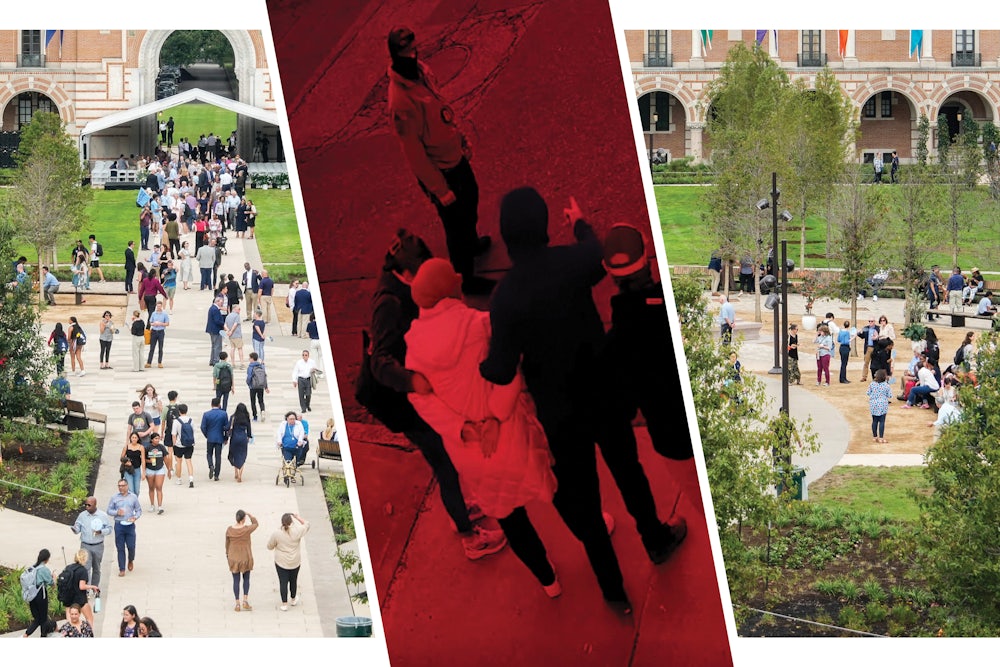In fall 2024, I taught a first-year undergraduate seminar at Northwestern University named “Oil and Water in the Gulf of Mexico.” I was also the faculty adviser for the 14 students enrolled in the class, who came to our campus from all over the world. On the first day, as we were getting to know one another, one of my students asked, “Can historians tell the future?” It was a question about our seminar topic—the future of places like my hometown, New Orleans, and lower Louisiana, one of the many places in the world dealing with the environmental challenges of climate change. It was also a question about the forthcoming U.S. presidential election. As someone who believes in the evidence of things unseen, I took the question seriously—and said I didn’t know, but if we could, no one would listen to us anyway.
When my class met on the day of the U.S. presidential election, I returned to my student’s question. We had spent no class time discussing what could happen; our focus on comparing the urban infrastructures of Chicago and New Orleans, two cities surrounded by very different bodies of water, had absorbed us. But we did our work in an increasingly hostile political context. Donald Trump and his supporters rooted themselves in an “America First” language that demonized non-European immigrants as dangerous criminals who stole jobs from U.S. citizens. More broadly, “America First” rhetoric simplified the complex global exchanges and interconnections of people, knowledge, and wealth that were foundational to the nation’s origins and underpinned our contemporary reality. Similarly, “anti-woke” and “anti-DEI” became shorthand for an ideology that claimed that nonwhites, women, and queers—with exceptions for those who hewed to Trumpian and other right-wing ideologies—had been unfairly elevated over more-qualified white straight men because of identity politics. These campaign talking points culminated in a Madison Square Garden rally the week before the election that was a horrific echo of an event held there by Nazi sympathizers in 1939.
The Trump assault on international students and researchers ignores the collaboration necessary—economically, politically, and intellectually—for success, if not survival, in our hyper-connected global world. Nationally and internationally, the expansion of the U.S. higher education population to include non-U.S. citizens in the post–World War II era has been a critical part of this nation’s research, economic, and political success story. Many academic researchers are part of international teams, particularly in the sciences and business, but also in the social sciences, the humanities, and the arts. We share rather than duplicate knowledge production, imbued with the recognition that creating solutions to infectious diseases, famine, poverty, climate change, and much more must be understood regionally and globally to be truly effective. The federal government supported and welcomed these connections not only because of research, but also because the rich diversity of the U.S. higher education system was the envy of the world: It was a valuable tool of soft power, first in opposition to Soviet communism during the Cold War, and more recently as a way to exert political influence in a range of places around the world.
Sharp increases in international student enrollments occurred after the 2008 financial crisis, which temporarily decreased endowments across higher education but also spotlighted other emerging crises: How would American families continue to bear the costs of upward mobility via higher education? How would higher education survive the forthcoming decline in college-age students? Because international students are often from the elite classes, or are invested in by their governments, by and large they bring their own funding. In 2023, nearly 80 percent of their funding came from private sources, and the majority of that from “Personal and Family” sources (54.5 percent) and “Current Employment” (21.8 percent). These funds pay for their education, of course; but they also are a significant financial support for U.S. institutions and American students. Similarly, state schools from New York to Michigan to California calculate enrolling a percentage of higher-paying nonresident students in their budgets to support state resident students and offset the loss of state taxes that used to support their educational systems. Today, international students from all corners of the globe plow nearly $44 billion into the American economy annually.
Members of the Trump administration argue that they are rebalancing the politics of higher education by withdrawing federal money if schools do not remove “DEI” and “woke” ideas. By arresting international students and faculty who the administration claims without due process are Muslim terrorists or Chinese spies, they purport to be protecting students and the nation from destabilizing political influences. But the broad-based defunding of research universities that the federal government has threatened and enacted in these first months of the administration is not protecting the nation or improving free speech on college campuses. Rather, these actions will render our higher education system inoperative.
In fall 2024, my first-year students were born in or one generation removed from the Middle East, Africa, Latin America, East and South Asia, and Europe. During one class meeting, someone came to take one of my Middle Eastern students out of the class so that they could tell her that her family had survived the recent bombing of her home city. Many of my students by age 18 had already experienced some of the worst things that could happen to people: war, genocide, starvation, refugee camps. I had learned of these things as a historian, and as an increasingly obsessive follower of national and international news. My students and their families had lived through experiences and events that I had only read about.
The day before the election, I could feel my students’ anxiety. For the first half of my teaching career, as a rule, I never brought up contemporary politics or my own political views in the classroom. But in 2006, in the wake of Hurricane Katrina’s devastation of my hometown, New Orleans, I began researching and writing a book on New Orleans and my family’s history there, as a way to make sense of the city’s past and to understand what our future might be. I needed to investigate what environmental and geological scientists knew of climate change, and more—what they knew of the fragility of lower Louisiana in particular, and of coastal regions across North America and around the world. In a more direct way than I had ever experienced in my undergraduate and graduate programs in history, I found myself making connections between past and present that I had previously avoided.
In the classroom, I also found that my interest in recent history attracted a wider range of students than I’d taught previously. The vast majority of international students who come to the United States seek science and business degrees, not history. But the “Oil and Water” course and a previous iteration I taught at Emory University on the 2005 hurricane season and New Orleans have welcomed students educated in STEM who seek to explore questions that can’t be answered with scientific methods alone. In turn, their focus on contemporary issues enriches the questions I ask as a historian, even when the answers are still undetermined. I have been humbled by this generation’s ease with STEM disciplines and delighted in explaining to them how historians “experiment” with right and wrong answers when researching the past. Together over the years, we have challenged one another to ask more capacious questions about problems that exceed any one field’s answers.
Our explorations in these classes haven’t improved my ability to tell the future. I was wrong about the election. In my liberal-left bubble, I thought the Democrats would prevail. As our class meetings ended in early December, I and my students were in limbo, wondering which campaign promises would be kept and which ignored. One student used her final paper to control her free-floating anxiety by comparing the environmental actions of the first Trump administration with those outlined in Project 2025. She addressed the range of legal protections and responses to Trump’s first term, and how policymakers and activists were gearing up for his second. Other students used the interdisciplinary research methods of our course to investigate the environmental challenges of their home countries and how their governments had been effective and ineffective at addressing them. Still others examined the positive and negative effects of energy policies or new technologies and infrastructures. They had come to our campus and my classroom from all over the world, from across the United States, and from just across town, carrying their own and their families’ precious hopes and dreams for them and for the future. In 10 short weeks, I watched and guided them in their initial exploration of the tools available to them in an elite research university.
As the Trump administration arrested multiple international students who had spoken out against the war on Gaza and then threatened to stop Harvard from enrolling international students at all, I wondered how far this could spread. Trump and many in his administration are skeptical of the science of climate change. Would my students and I, regardless of citizenship status, be prevented from furthering our investigations of the environment and climate change? Would my international students be allowed to reenroll at all? Over the course of my fall quarter with them, and as the Trump administration attacked us all in the first six months of 2025, one question emerged for me: How do we protect not only ourselves, but our common future?
The internationalization project of U.S. universities has always struggled with the line between education and indoctrination: Are we giving non-U.S. students and researchers the tools to explore freely, or are we trying to convince them of the right and might of America’s ideologies of capitalism and freedom, however they are defined at any one moment? These complex and contradictory goals are often metabolized in the variety of classrooms, laboratories, and events students and faculty experience together; the diverse populations of students, faculty, and staff that interact with one another; and the influences of the surrounding communities that support these institutions. The expansion of who has access to higher education, from a tiny elite to an ever more diverse group, has led to a fervent exploration of increasingly diverse possibilities. The U.S. higher education system has supercharged the U.S. economy and many others, and elevated life expectancies, experiences, and desires nationally and globally. As the United States shrinks from the expansive exploration of a variety of ideas to embrace a paranoid fear of dissent, we will lose the ability to participate in the creation of a commonwealth of shared knowledge that we need to secure our global future.




